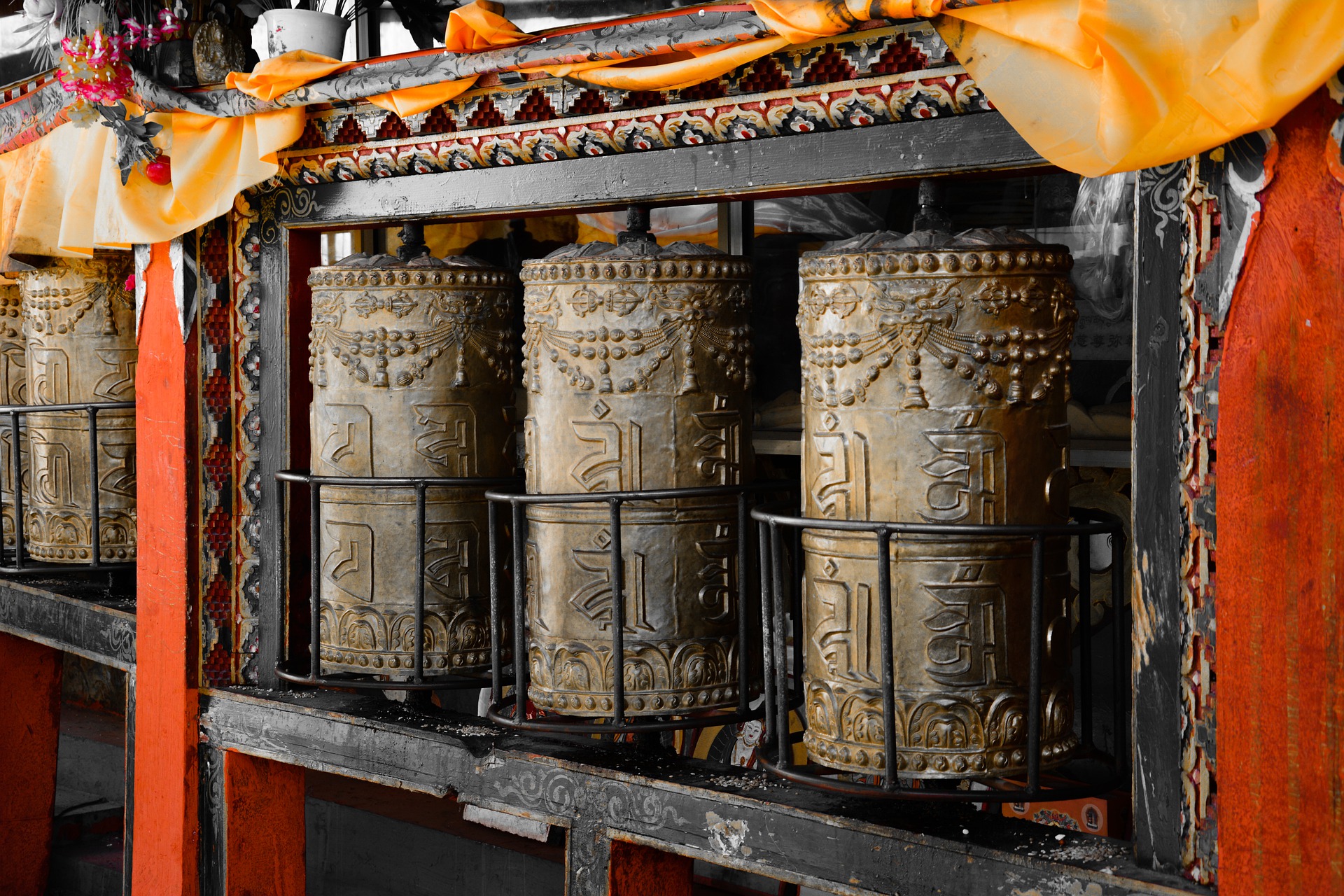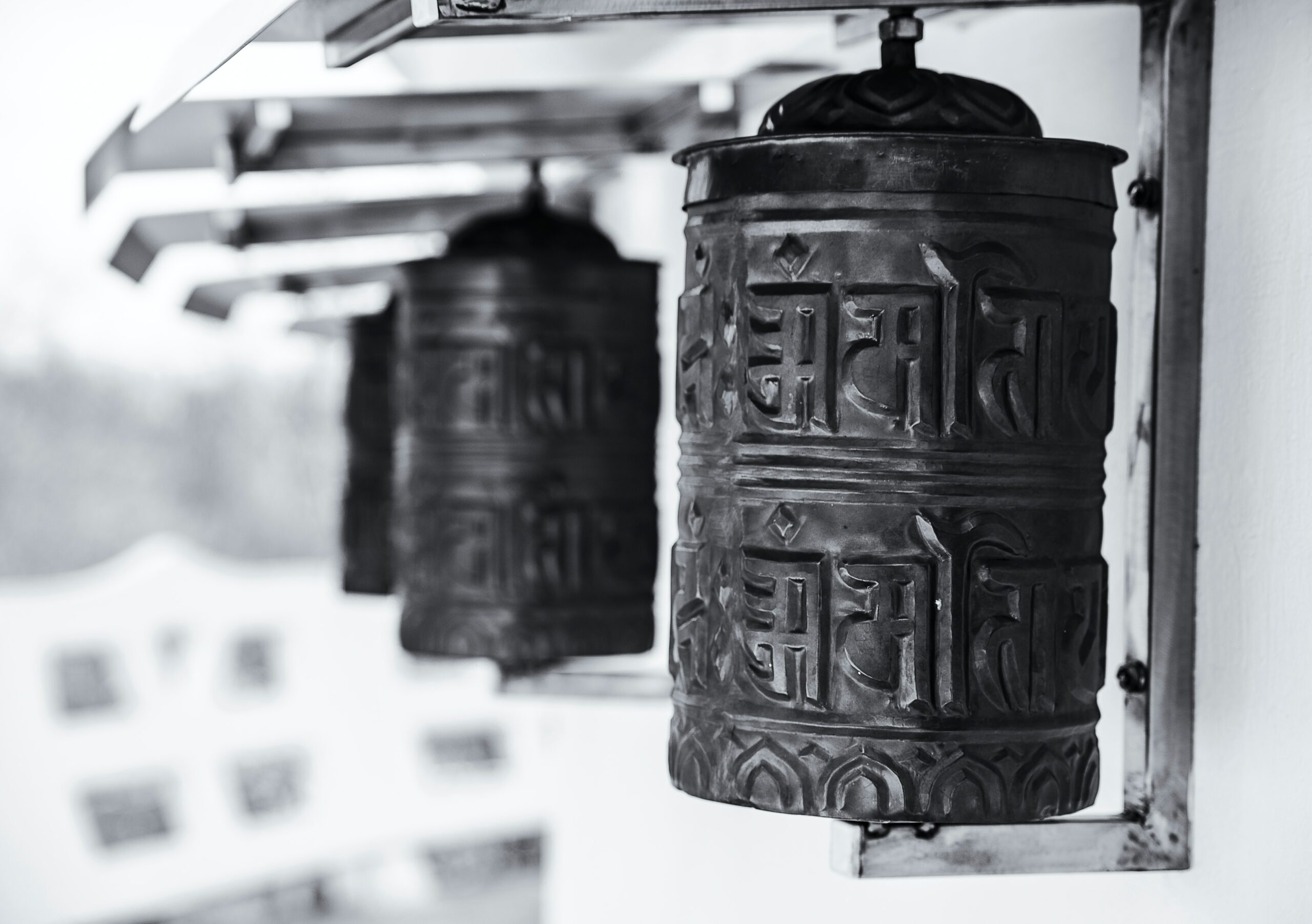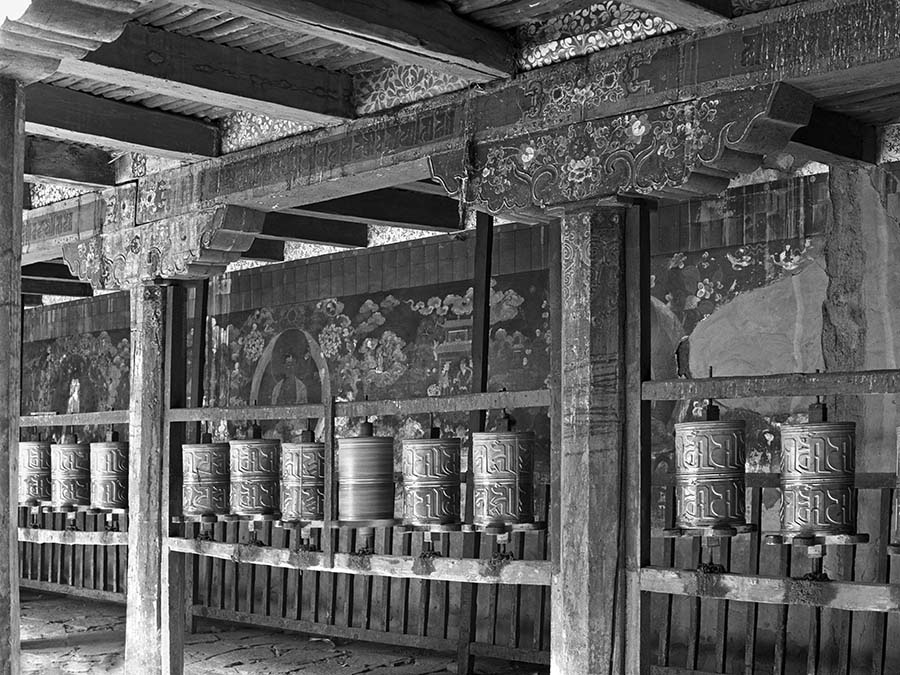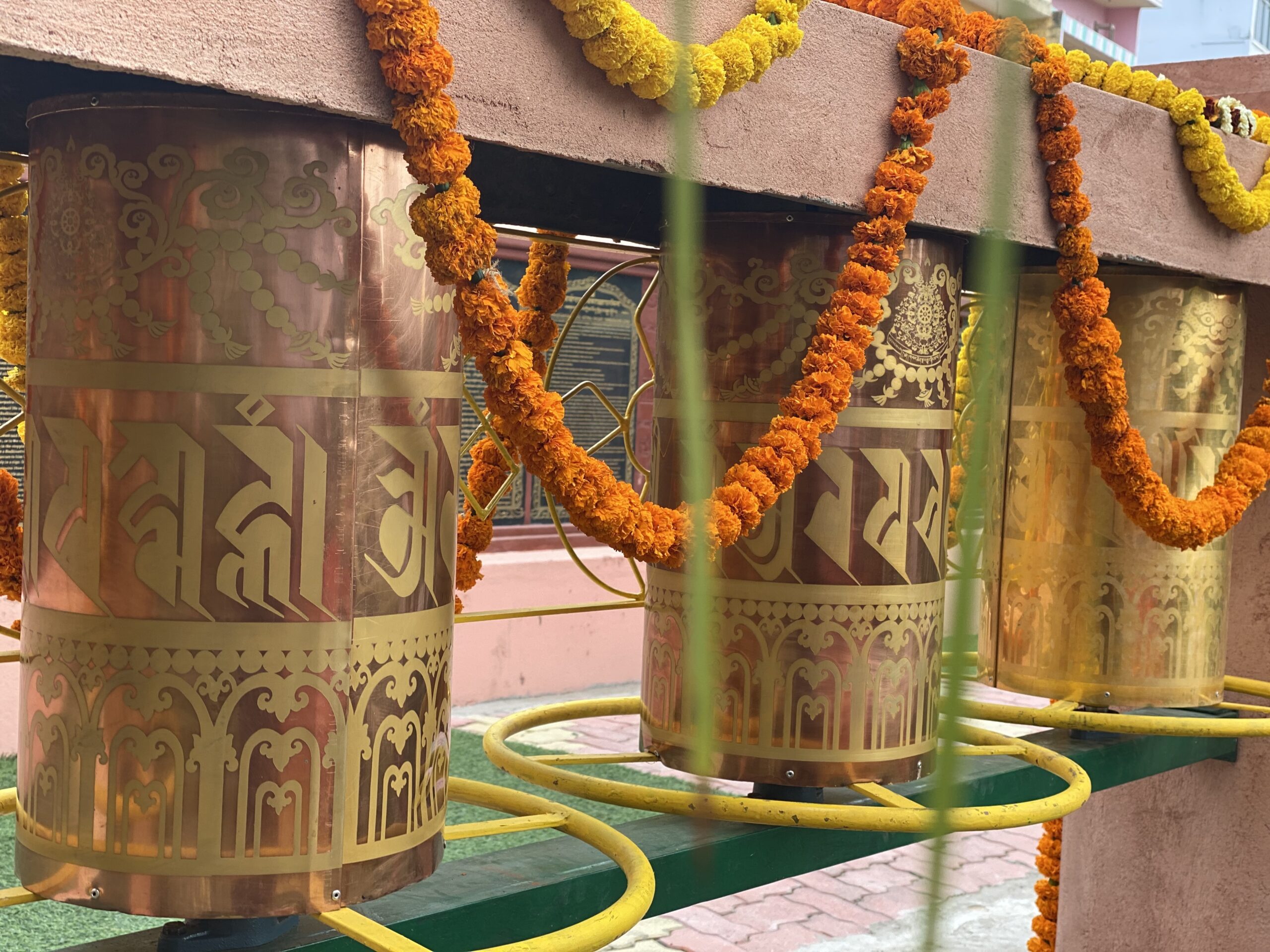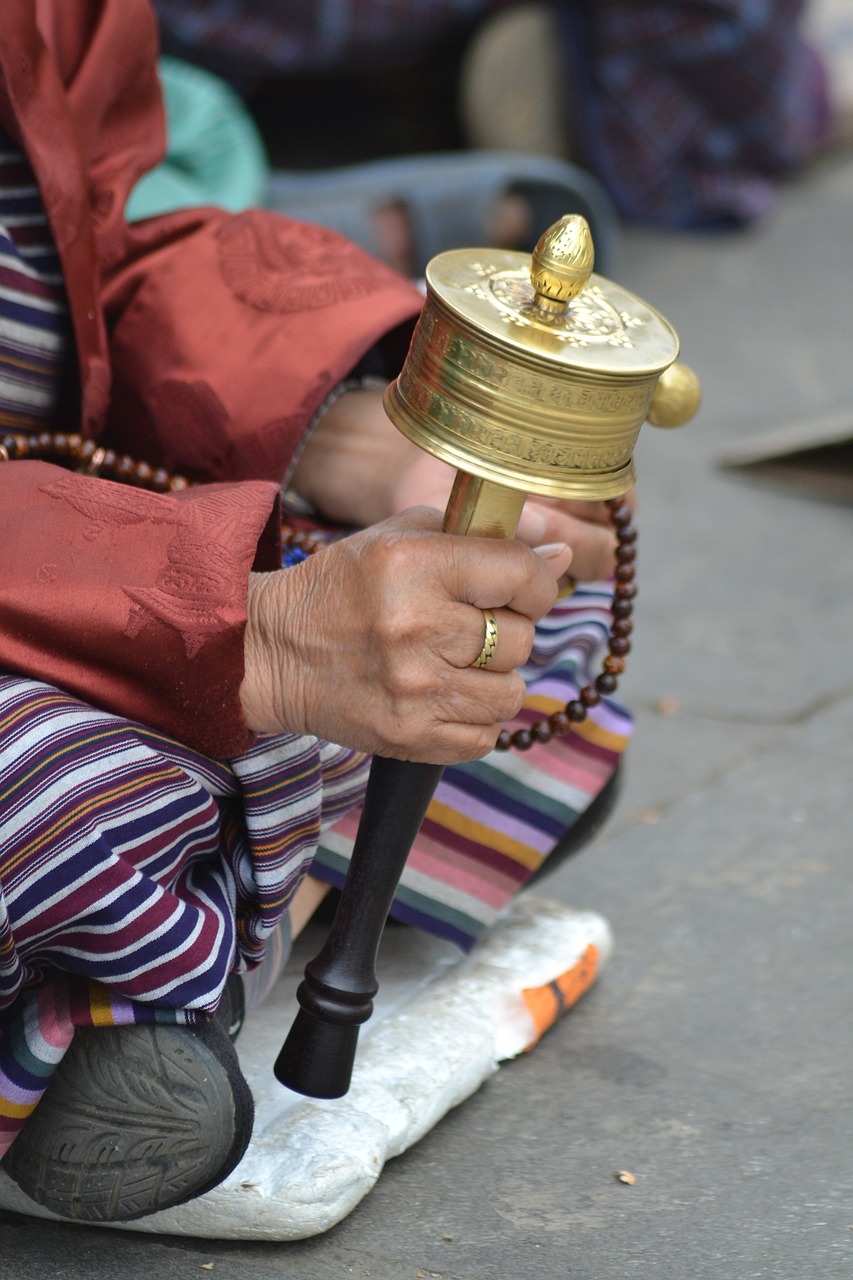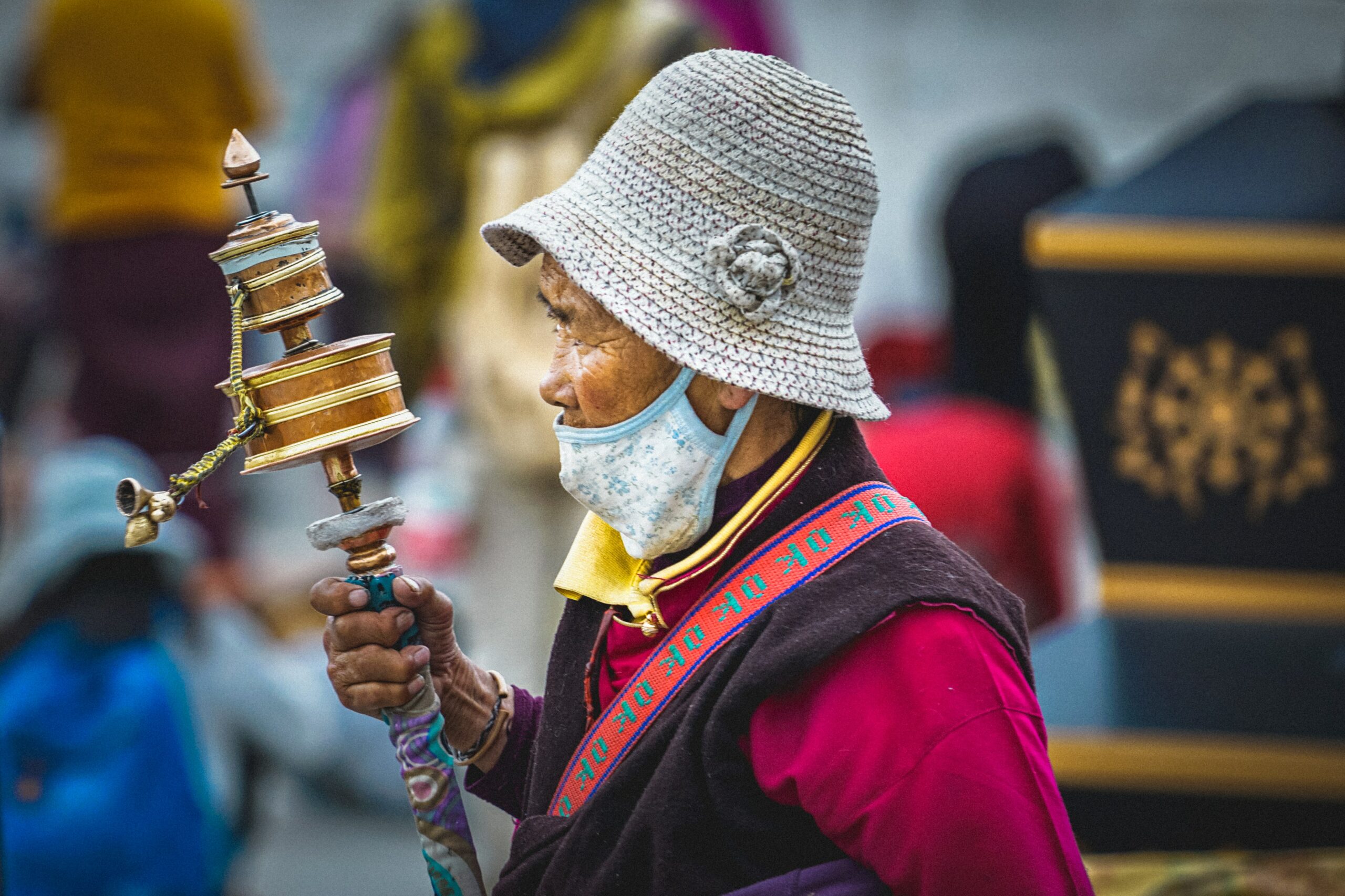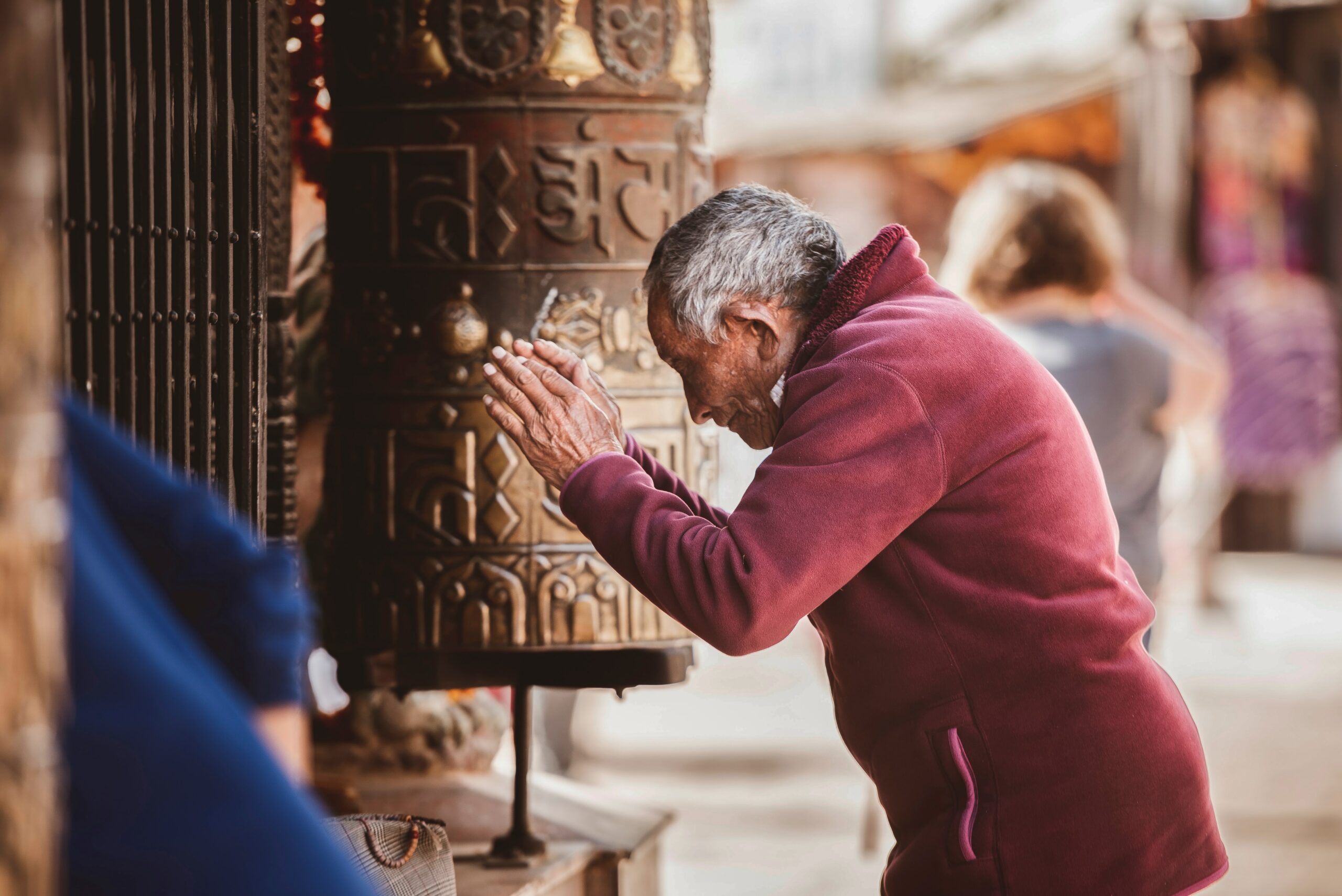Tibetan Culture
Tibet is a huge culture for only six million people. A small country, with a very big influence. Tibet's not so simple.
~ Tarthang Rinpoche
People
Subsisting on a rugged, untamed land for thousands of years, the Tibetan people embody the qualities of strength, resilience and faith. Archeologists have discovered evidence of early Tibetan farming villages dating back to 3500 B.C. Around 3000 B.C. bands of hunters in steep regions unsuited to agriculture developed a mobile, pastoral culture, centered around the seasonal migration patterns of animal herds. Since that time, Tibetan laypeople have primarily consisted of farmers and nomads.
In the middle of the 8th century, King Trisong Detsen, invited the Abbot Shantarakshita and Guru Padmasambhava from India to establish a firm foundation for Buddhism to flourish in Tibet. Overcoming significant obstacles, Tibet’s first monastery, Samye was built, the first monks were ordained, and the king established special laws that provided for their support. The remarkable confluence of worldly, intellectual, and spiritual power embodied in King Trisong Detsen, Abbot Shantarakshita and Guru Padmasambhava, allowed them to forge an extraordinarily rich foundation for a vibrant culture of dharma to proliferate to modern times. The Nyingma tradition is the ancient school of Tibetan Buddhism introduced by Padmasambhava and based on the first translations of the Buddhist scriptures from Sanskrit into Tibetan, carried out until the late 10th century.
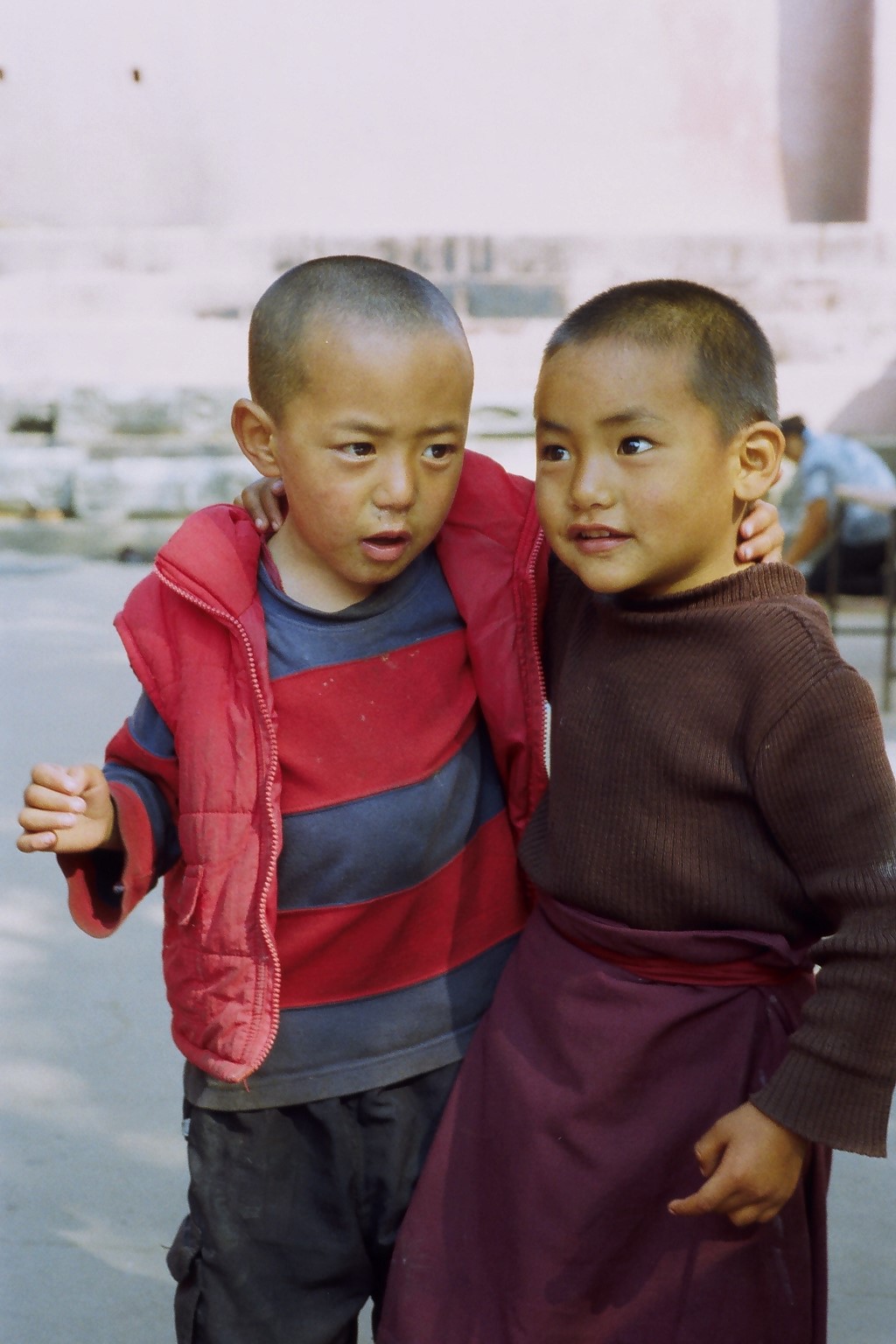
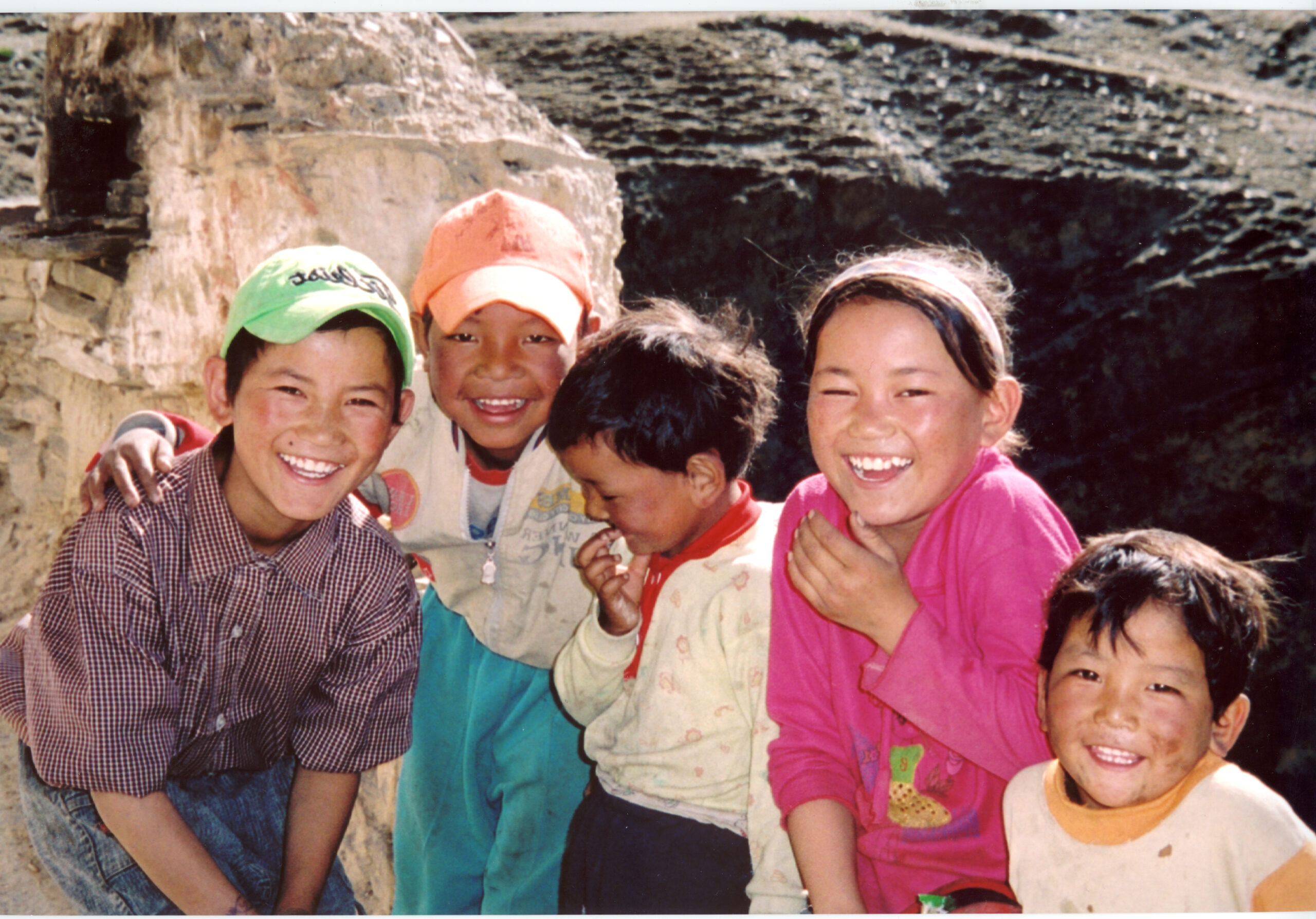
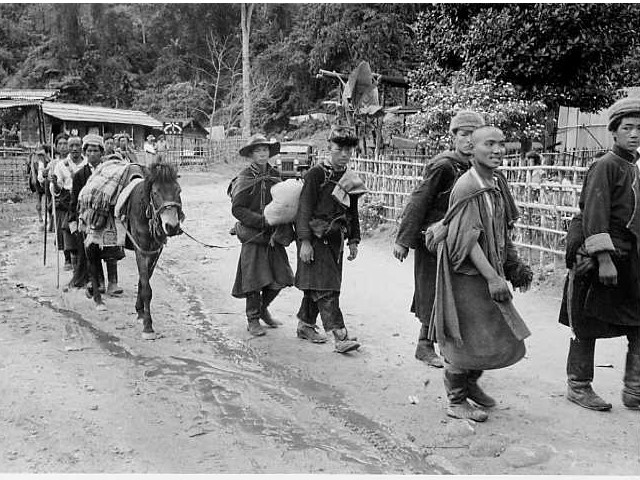
Landscapes
Nestled among the clouds, Tibet is the highest region on earth, with an average elevation of 12,000 feet. It varies widely in its geography, with areas of desert, a semi-tropical area to the southeast, and high mountains on three sides, including the Himalayas. Since most regions lie above the timberline, much of the terrain is rocky and barren, but hidden below the mist are lush valleys and swift-flowing rivers.
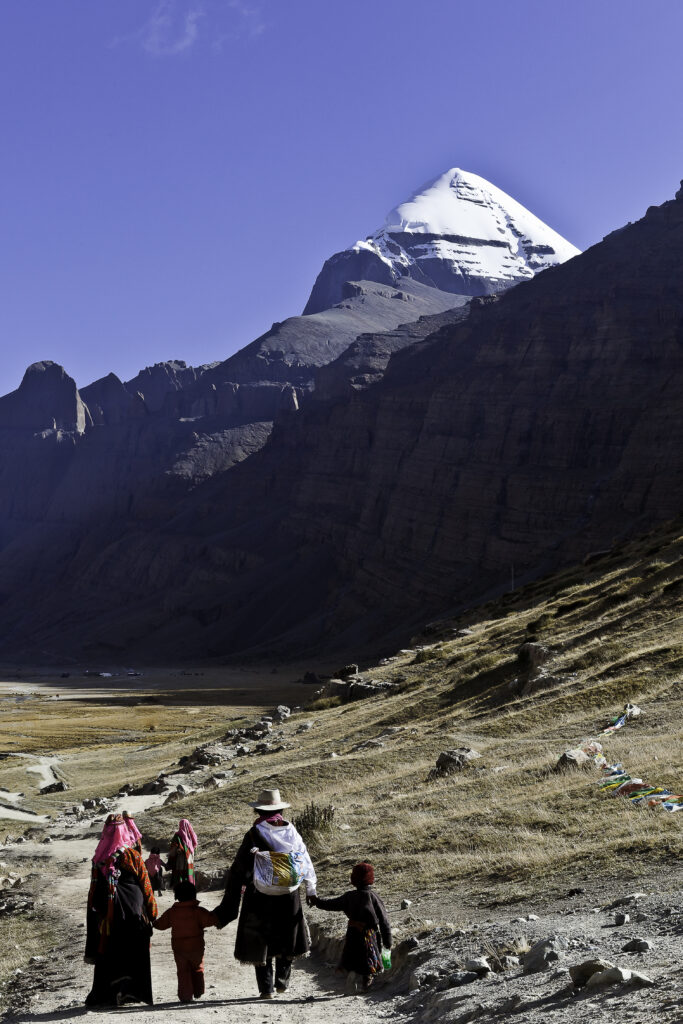
Architecture
Tibetan architecture is influenced by the geography and climate of the Tibetan plateau and traditional architectural styles of India, Nepal and China. Stone houses and sturdy woolen tents blend seamlessly into the vast and jagged landscapes. Stone houses are designed to conserve warmth by incorporating flat roofs and are built to protect against earthquakes. For thousands of years, here in one of the most extreme environments on earth, Tibetan nomads have lived in tents, known as bas, made from the thick wool of yaks.
The beautiful artistry, particularly in the monasteries, reflects the rich cultural and spiritual heritage of Tibet. Colorful paintings made from semi-precious stones, roots, berries, and minerals adorn many buildings. Complex carvings, sculptures and fluttering prayer flags reflect the spiritual tradition that is inextricable from the everyday lives of Tibetans.
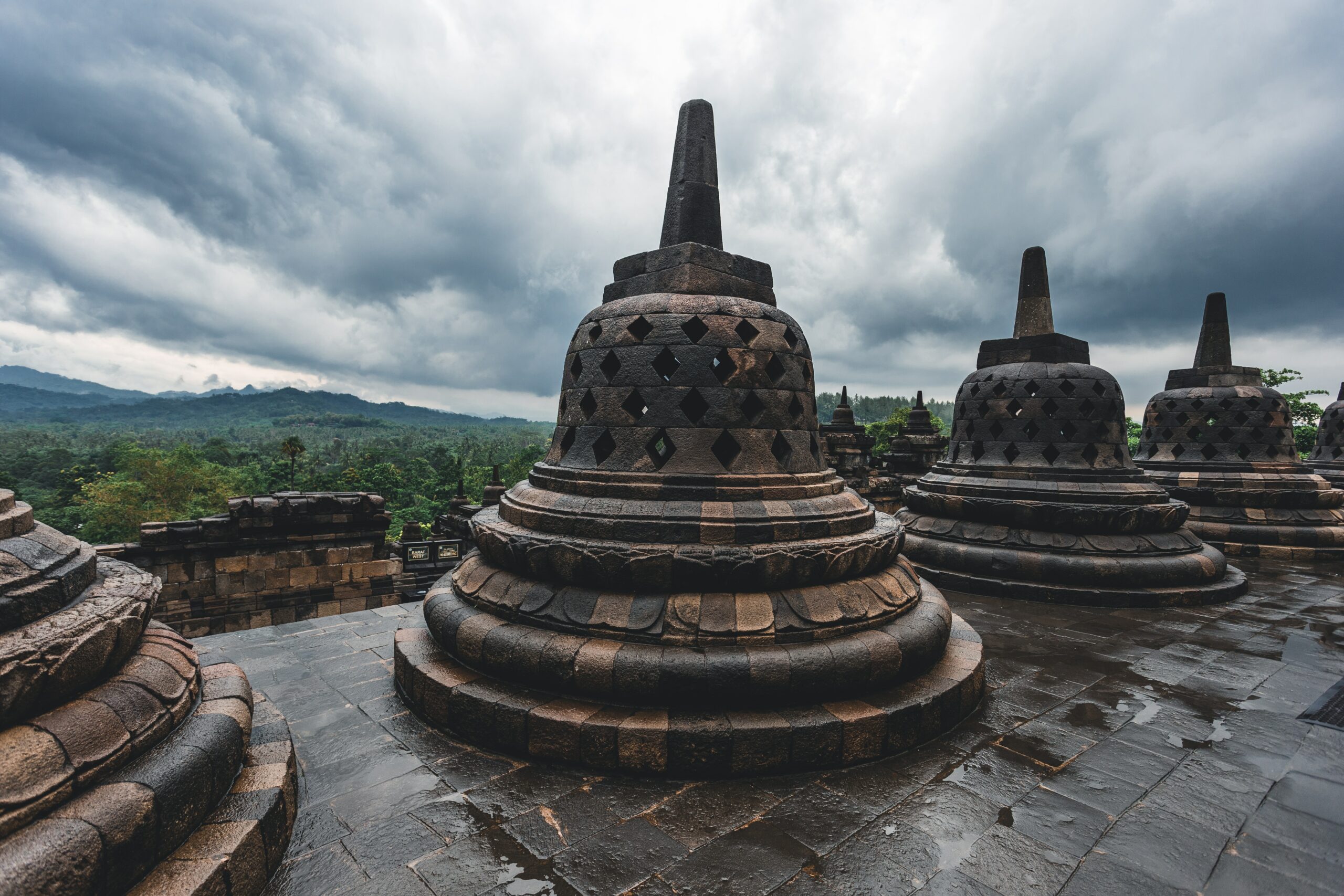
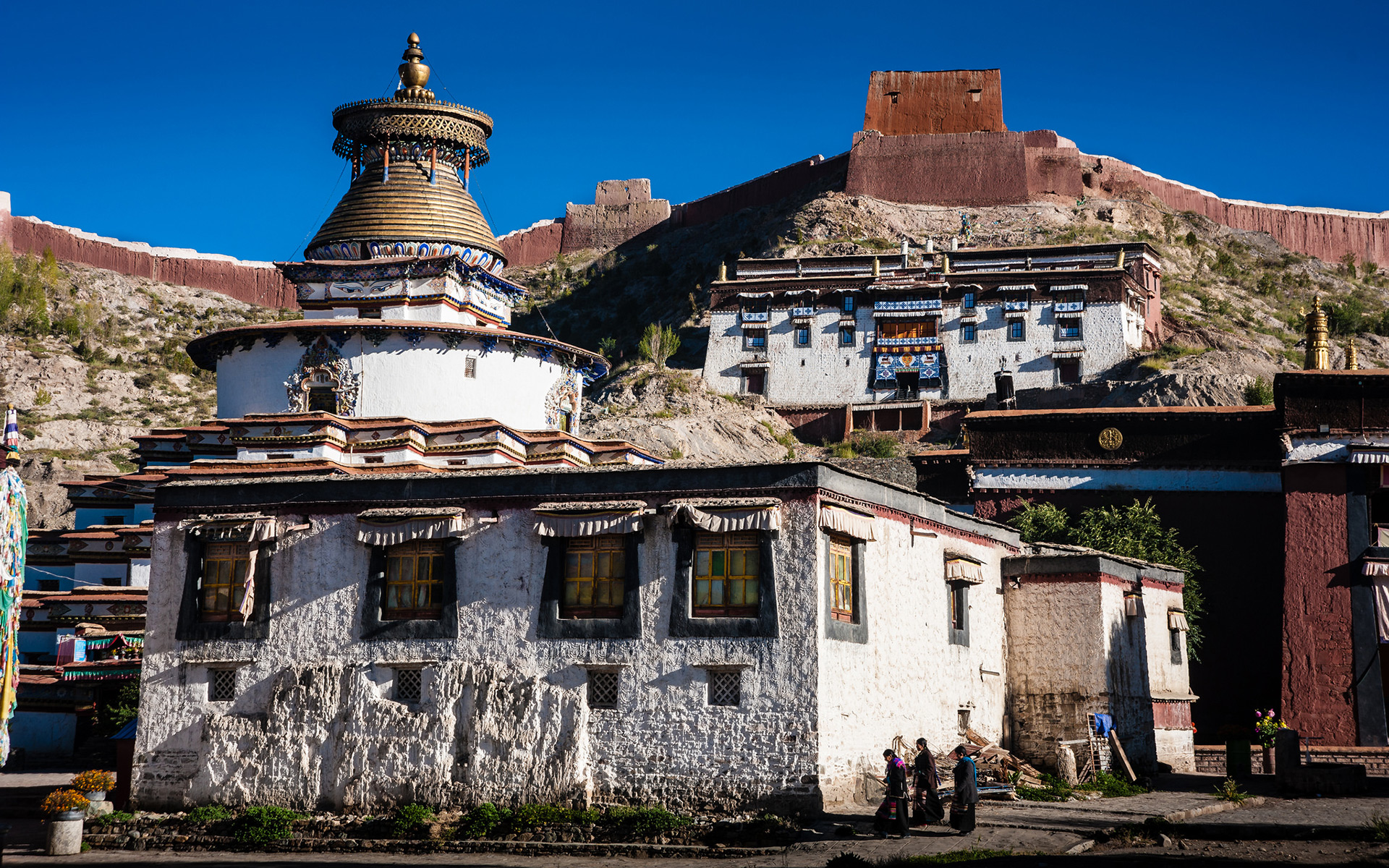
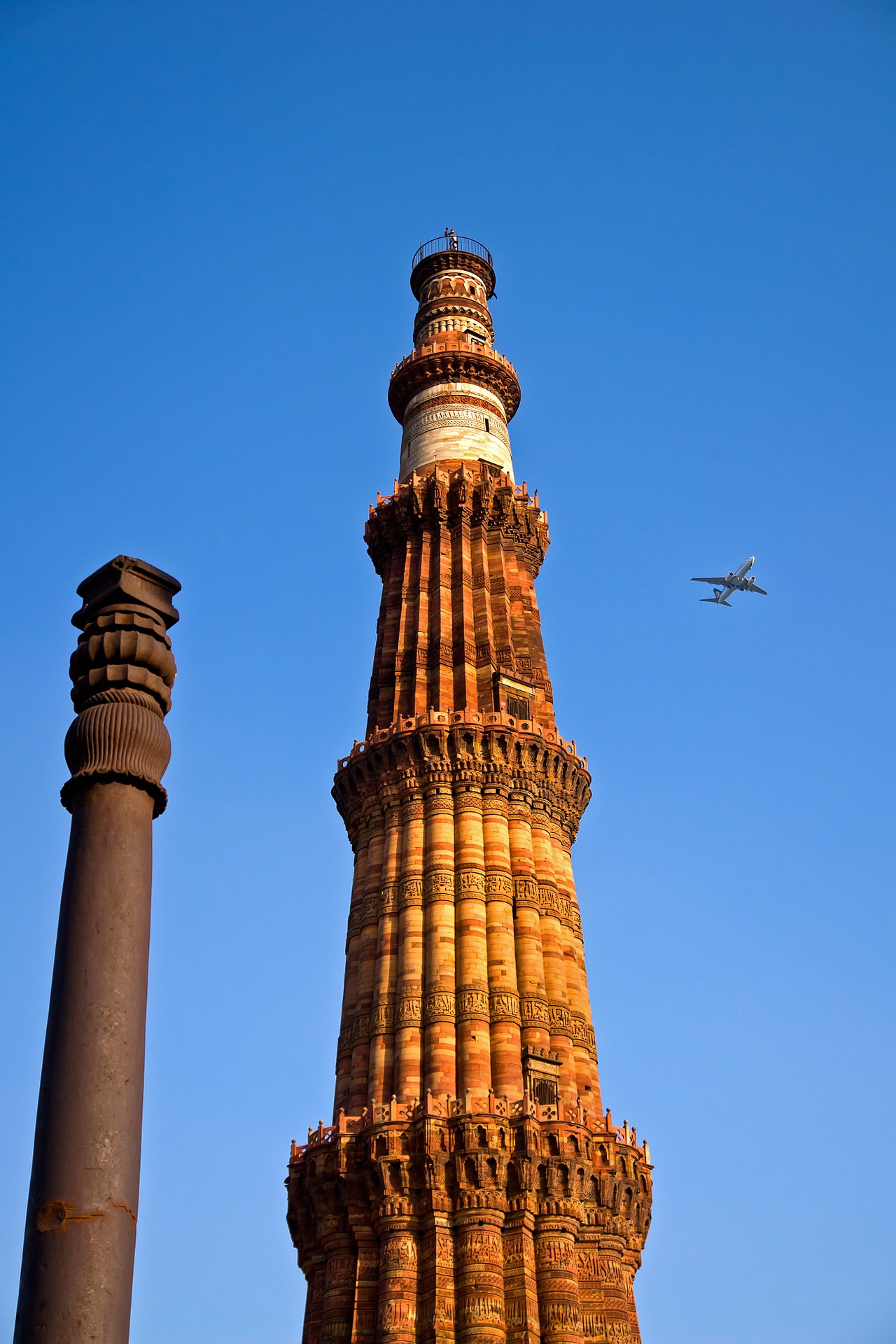
Temple Interiors
Works of art are usually commissioned by monasteries or lay patrons. The execution adheres to traditional guidelines regarding design, materials, proportions, symbols, and colors. Artistic creations are usually anonymous, in keeping with the cultural values of transcending the individual ego and attachment. Completed pieces reflect the inherent power to assist practitioners along their spiritual journey—small bronze images portray meditation deities and prayer wheels release compassionate energy with each rotation in all Four Directions.
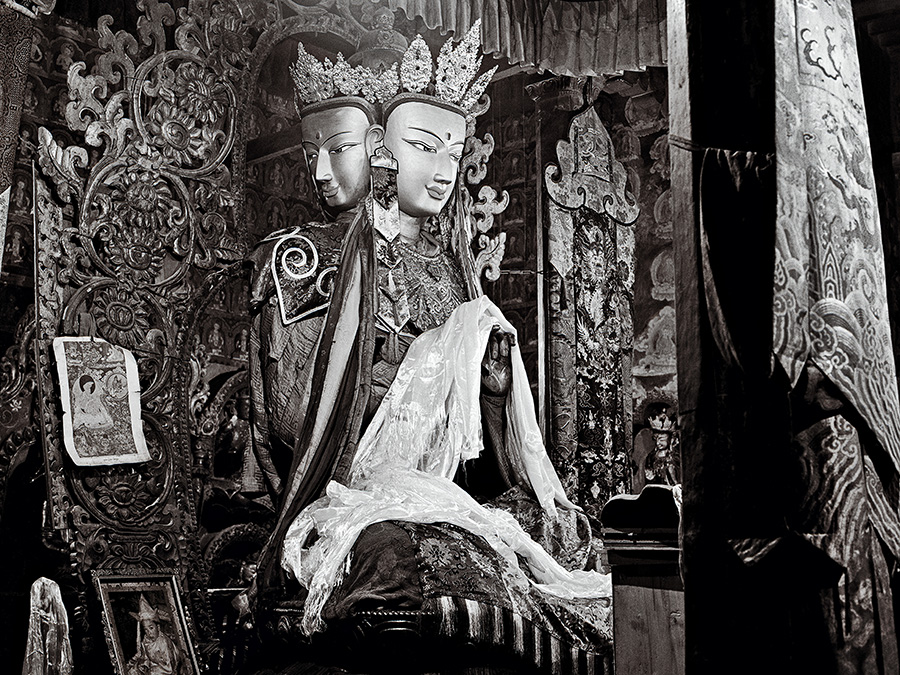
STUPAS
Stupa in Tibet
Enlightenment Stupa at Odiyan Retreat Center, northern California
An ancient and important sacred structure found in all Buddhist cultures, the stupa is the quintessential symbol of enlightenment. It is believed that, by communicating to subtle levels of consciousness, stupas call forth the potential for awakening that all beings have within them.
“Stupa” is a Sanskrit word meaning “pile” or “heap.” Constructed according to descriptions given in sacred texts, a stupa’s central form includes a base and three steps, the rounded dome, and the surmounting parasol. Often, many additional elements are added, such as gateways, paths, and additional bases, but “stupa” generally refers only to the central form.
Most stupas contain relics of the Buddha or other holy beings, while others may hold statues, paintings, mantras, or prayers that represent the body, speech, and heart of the Buddha. These sacred objects empower the stupa with the enlightened compassion of the Buddha and other great teachers.
The mandala serves as a blueprint for a stupa’s foundation, symmetry, and orientation, forging a connection between the inner realm of experience and the outer physical cosmos.
Focused by the stupa, the mandala’s universal principles of harmony and balance attract the heart and mind of living beings and bring them home to the quiet center from which flows all enlightened qualities.
~ Tarthang Rinpoche
For more information about stupas, please contact Dharma Publishing and reference:
Tulku, Tarthang, and Elizabeth Cook. “The Stupa: Sacred Symbol of Enlightenment.” Crystal Mirror Series, Vol. 12, Dharma Publishing, 1997.
The Language of Tibet
Inspired by the extraordinarily rich Buddhist civilization of India, the rulers of Tibet longed to establish Buddhism in their land but lacked a written script to facilitate the translation of its scriptures. In the 7th century, King Songtsen Gampo systematically prepared the foundation for the transmission of Buddhism to Tibet. Foreseeing the need for a written language suitable for translating Buddhist texts from Sanskrit, Songtsen Gampo appointed his minister, the capable scholar, Thonmi Sambota, to travel to India and develop the Tibetan system of writing.
The first writing to use the Tibetan alphabet delineated rules of conduct for all Tibetans to follow. These sixteen rules were based on moral virtues from the Buddhadharma.
In the 8th century, Tibet’s thirty-eighth king, Trisong Detsen, invited the foremost Buddhist scholars from India to come to Tibet and formally establish the Dharma. He also selected 108 young scholars to make the perilous journey over the Himalayas in order to be trained as translators in India. They returned with expert Indian panditas from the great Buddhist university of Nalanda and beyond, and close to 1,000 Sanskrit Buddhist texts. Within a single generation, the Tibetan translators and Indian panditas had succeeded in translating the Vinaya, Sutras, and Abhidharma, as well as many treatises by Mahayana masters and the entire body of Tantras.
Since the classical Tibetan language was expressly created for the purpose of Dharma translation, it contains many specialized words to articulate Buddhist concepts. For example, there are numerous terms that describe “mind,” each with a slightly different meaning. For anyone engaged in the serious study of Tibetan Buddhism, it is important to learn the classical Tibetan language. By understanding the subtlety of Tibetan terms, one can gain a deeper understanding of the texts.
Sacred Texts: The Heart of Tibet's culture
As Tibetan script was based on Sanskrit, the sacred language of India, the motherland of Buddhism, and created in order to bring the Dharma to Tibet, Tibetans regard it as sacred. Accordingly, texts are never put on the ground or stepped over, and damaged pages containing Tibetan script are never thrown away, but instead respectfully burned. To study and practice with these texts is to enter the realm of the sacred; they are the bridge from the ordinary mind to transcendent wisdom. Indeed, practitioners revere the texts as the living embodiment of the Buddha.
Tibetans have a profound relationship with the physical text. Even yogis who have renounced all material possessions may leave this world with only a beloved text by their bedside. Engaging with the physical text with an attitude of devotion, as if it were the most noble living being, is deeply rooted in the culture. Whenever Tibetans receive or put away a text, they briefly bring it to the forehead, a gesture of deep respect for the transformative knowledge that is within.
Tibet’s rich cultural heritage is embodied in these texts, which are the basis for the continuity of its living tradition. Throughout the history of Buddhism, with the support of devout patrons, the teachings of the Buddha and Buddhist masters have been preserved on palm leaves or paper, and by wood block or printing press. The production of sacred texts has always been lauded as one of the highest forms of meritorious activity, leading the individual and society toward enlightenment.
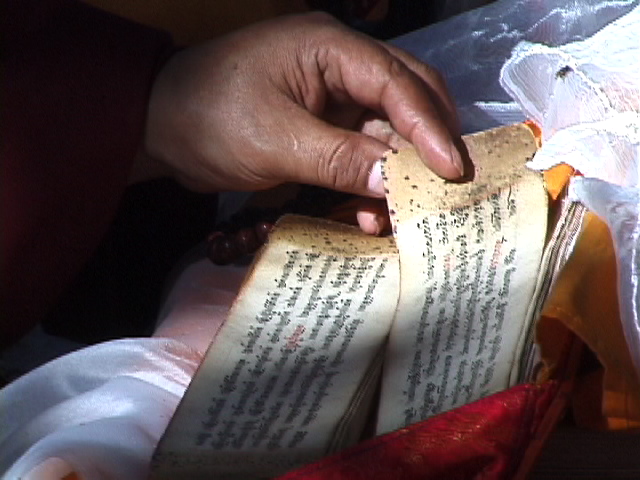
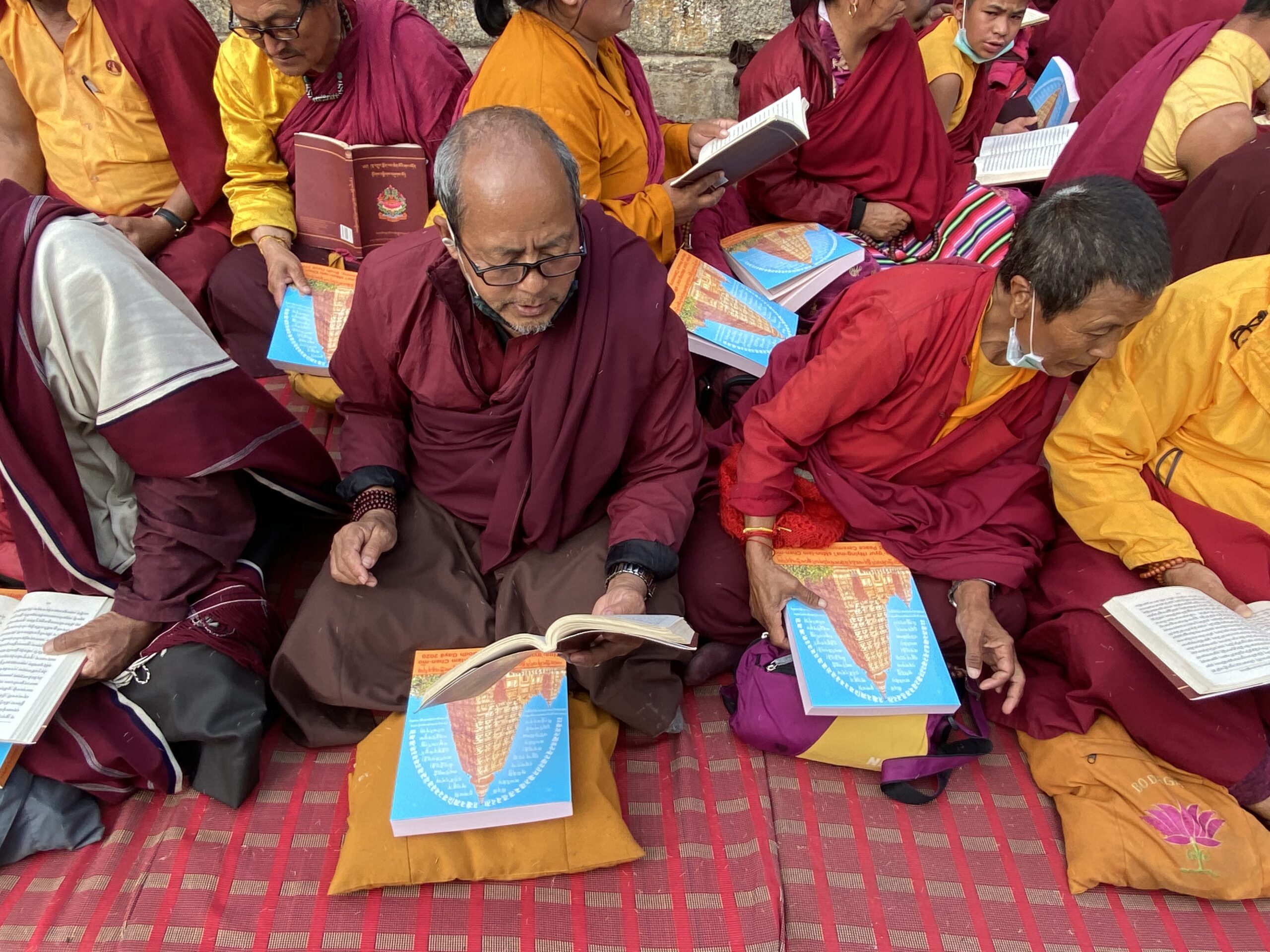
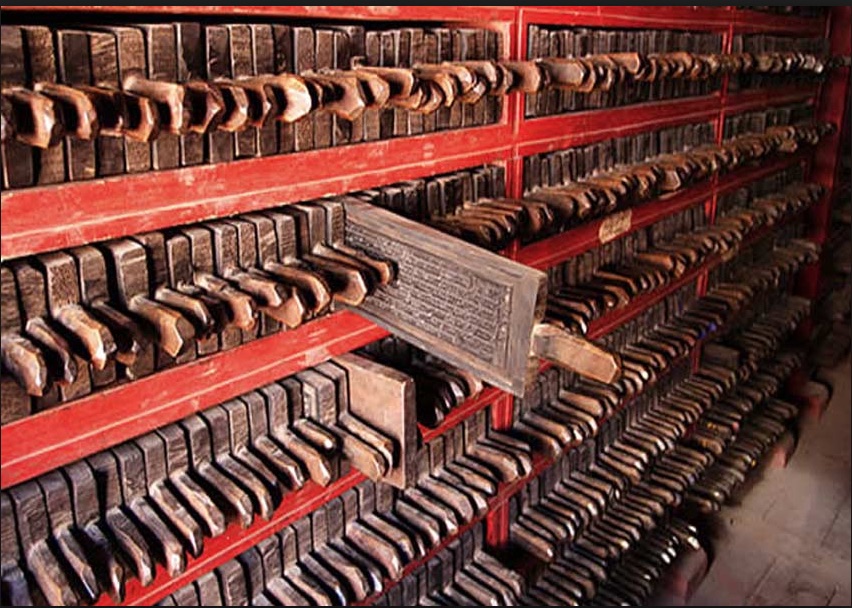
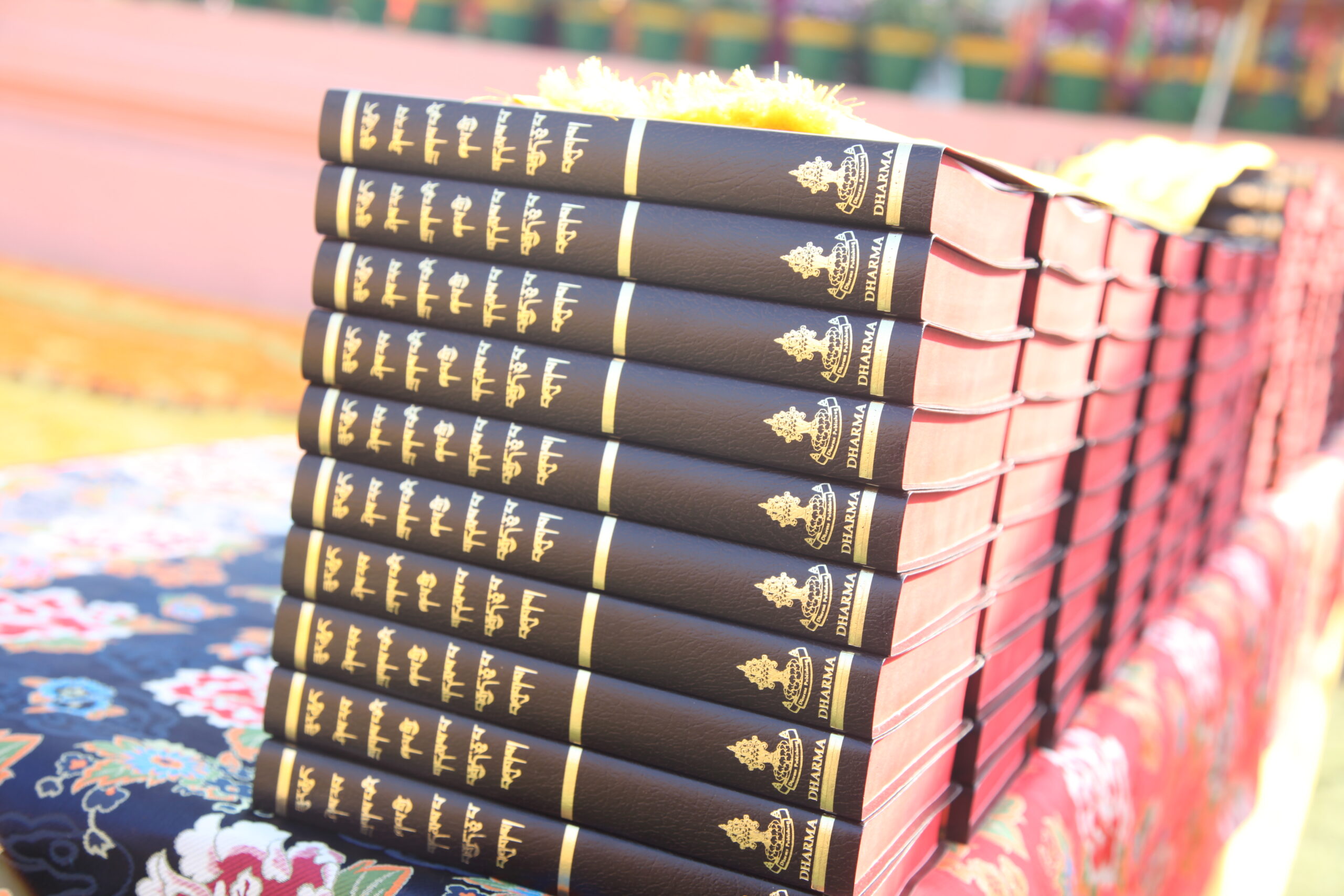
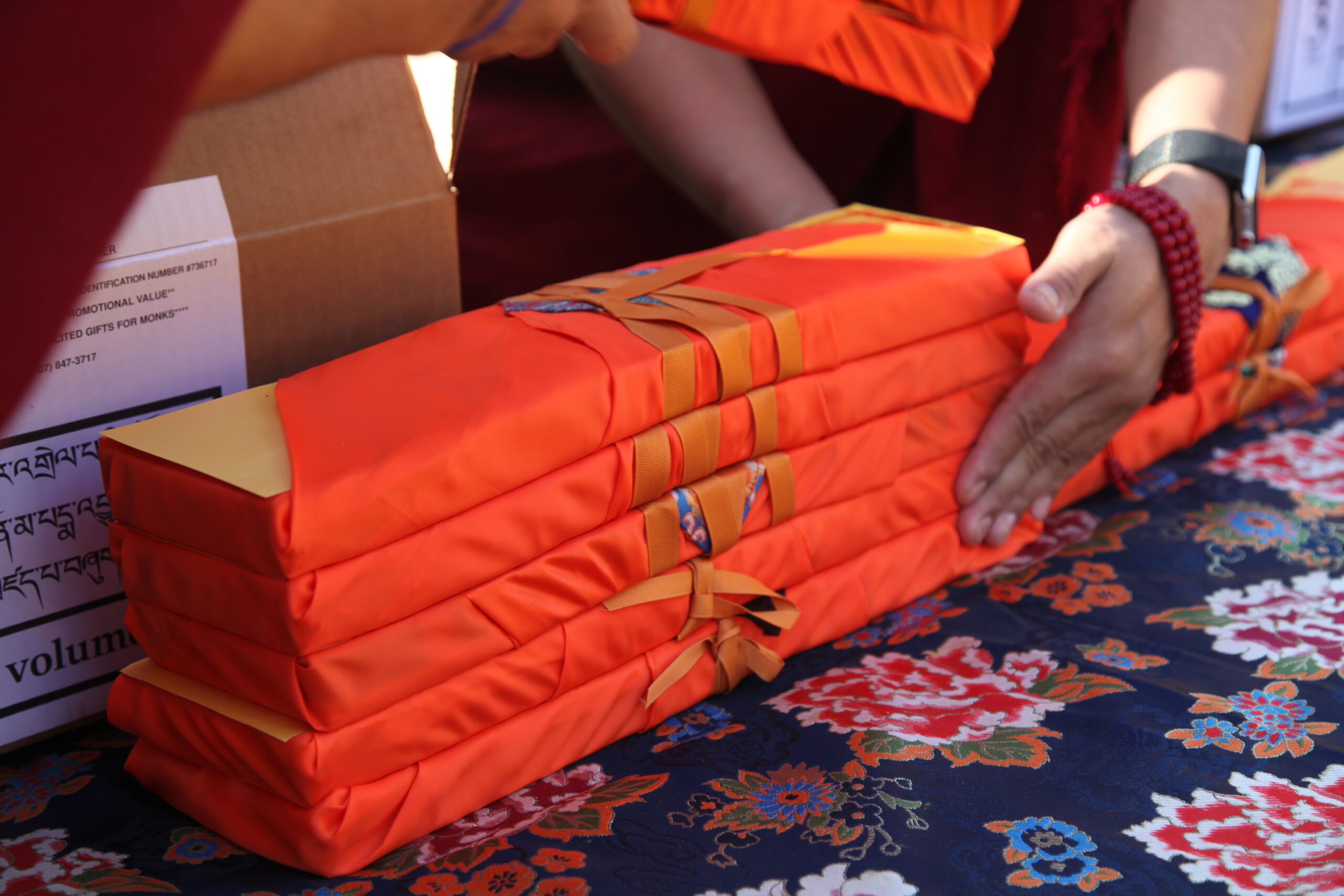
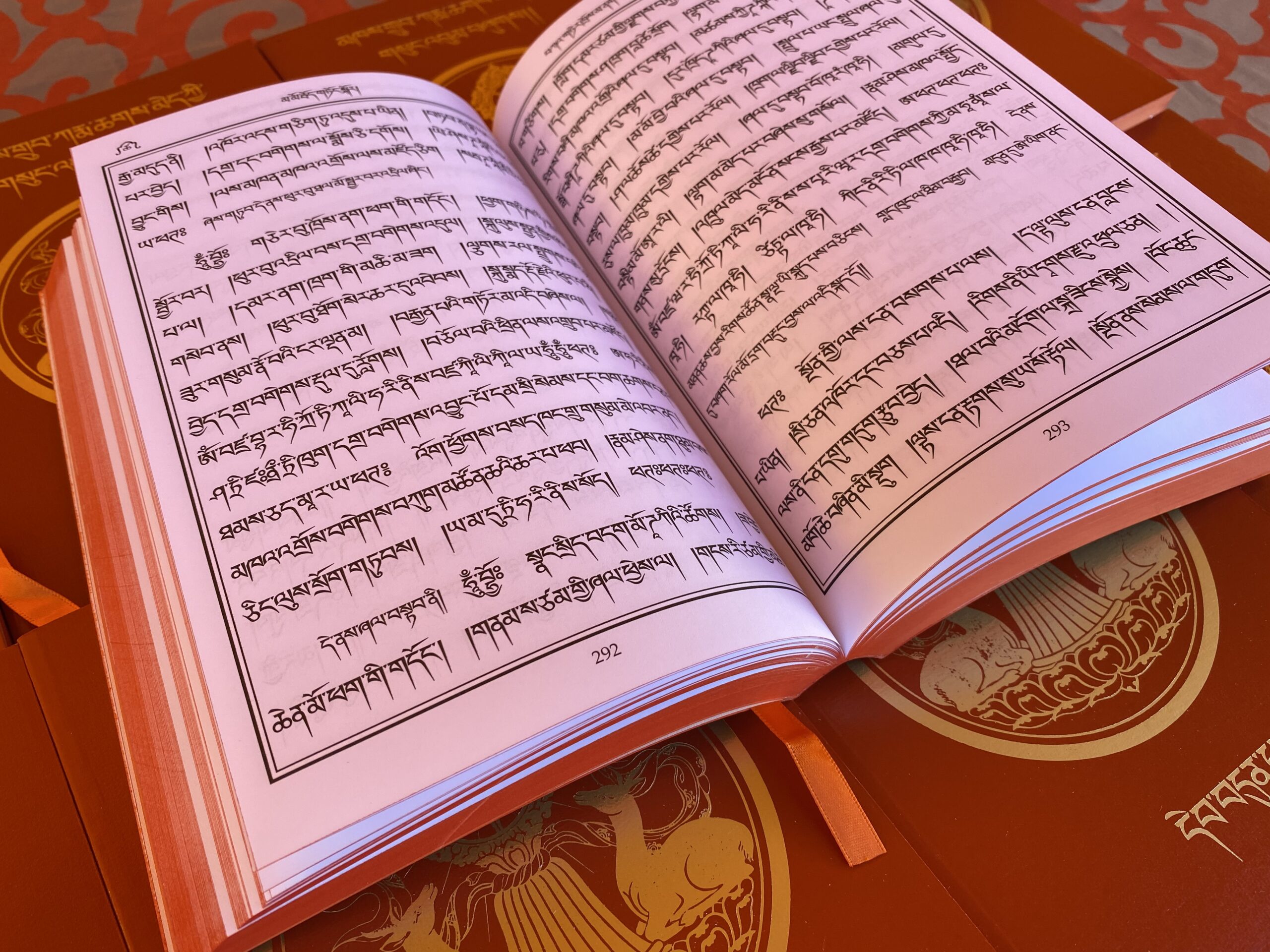
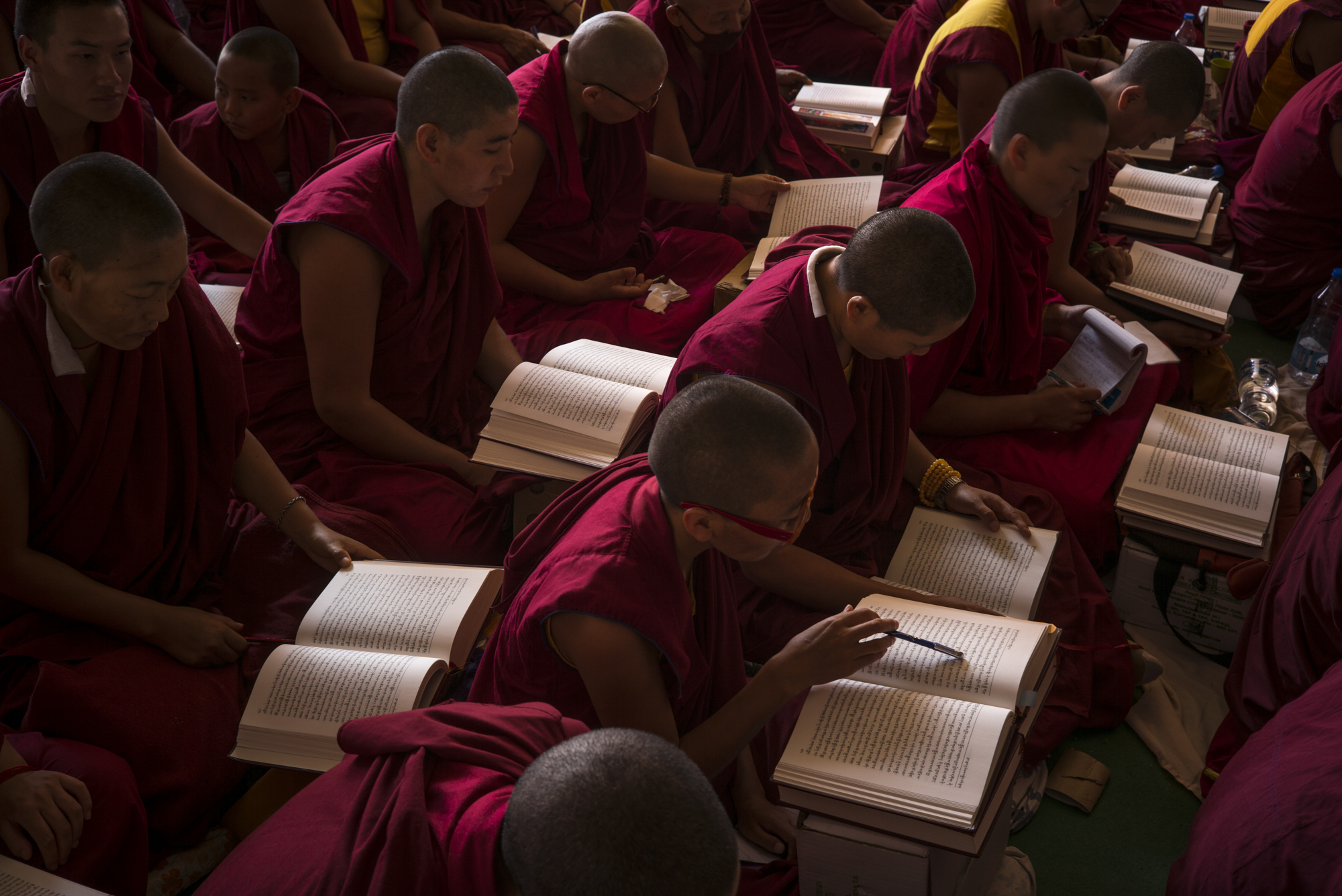
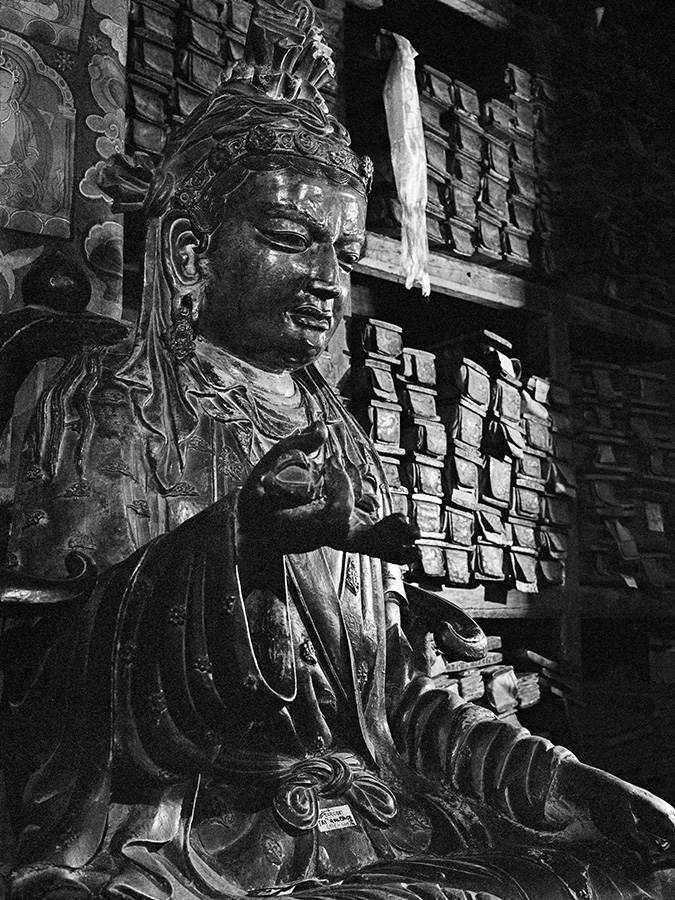
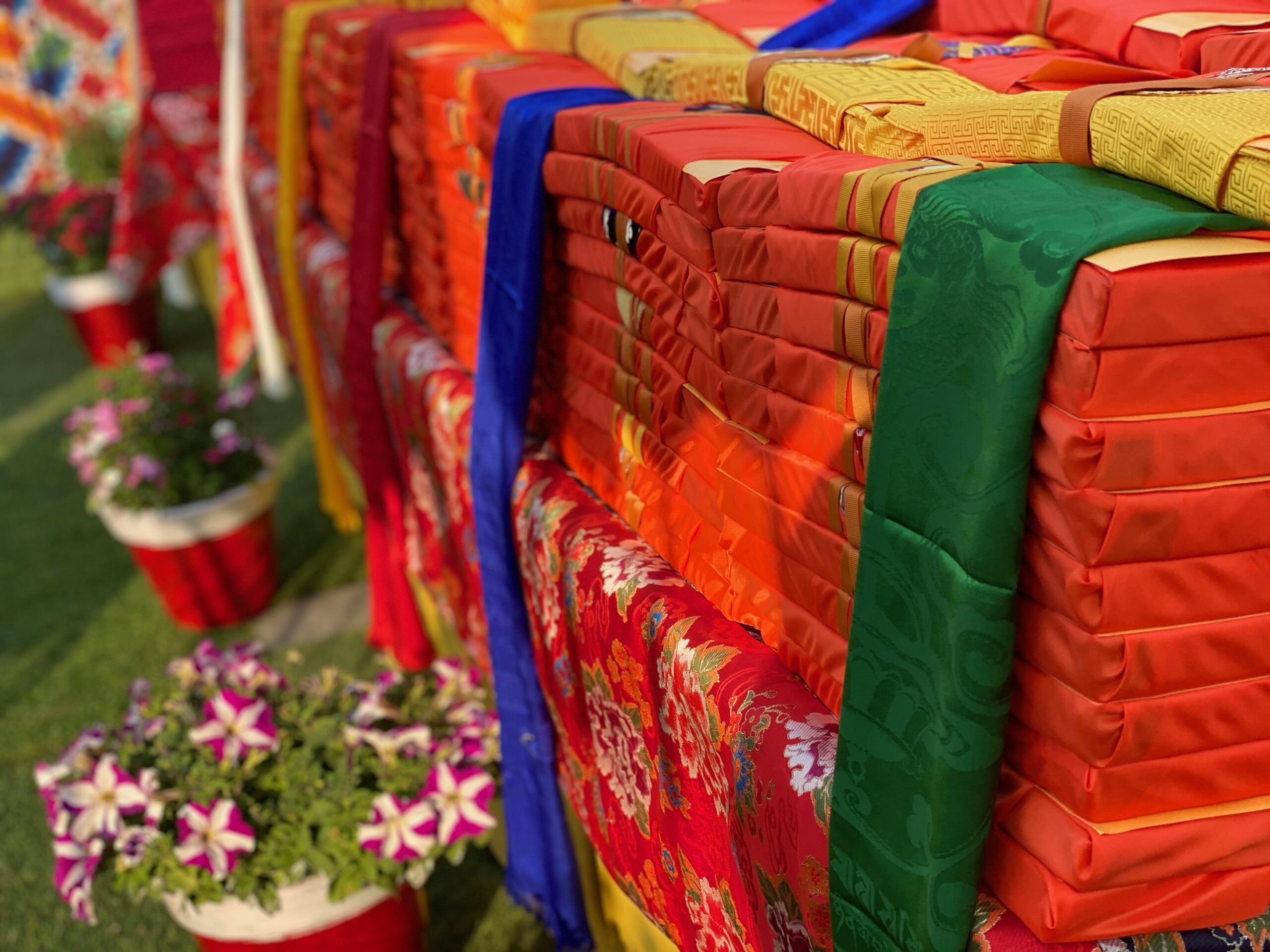
Mandala
The mandala portrays the five traditional elements – earth, air, fire, water, and space – which combine to form our beautifully unified world, the setting for all life. From these elements arise our five senses, which can unite together with conscious mind to manifest realization. The mandala is a pictorial representation of the undefiled mind, which demonstrates that perfect realization encompasses all things.
Traditional Mandala
A traditional mandala depicts a beautiful temple as seen from an aerial view. On the outer border is a ring of fire, a symbol of the transformative qualities of knowledge that can illuminate our existence and dissolve the obscurations that bar us from entering the mandala. The next layer often includes a ring of vajras, symbols of the diamond-like indestructibility of the teachings, with their emphasis on skillful means and enlightened action. A ring of lotus blossoms follows the ring of vajras. The lotus grows out of muddy water to emerge pure and unstained. It is a traditional image that symbolizes the promise of transformation for all beings, for the purity of our buddha-nature blooms out of the mud of samsara.
After passing through these three rings, we reach the multi-hued walls of the temple itself. Each wall has an arch or pagoda in the center, representing the doorway that leads to the heart of the mandala, where a deity is seated on a jeweled throne supported by a lotus. Different mandalas portray different deities, each of which can be thought of as an aspect of consciousness that can be transformed into enlightened awareness.
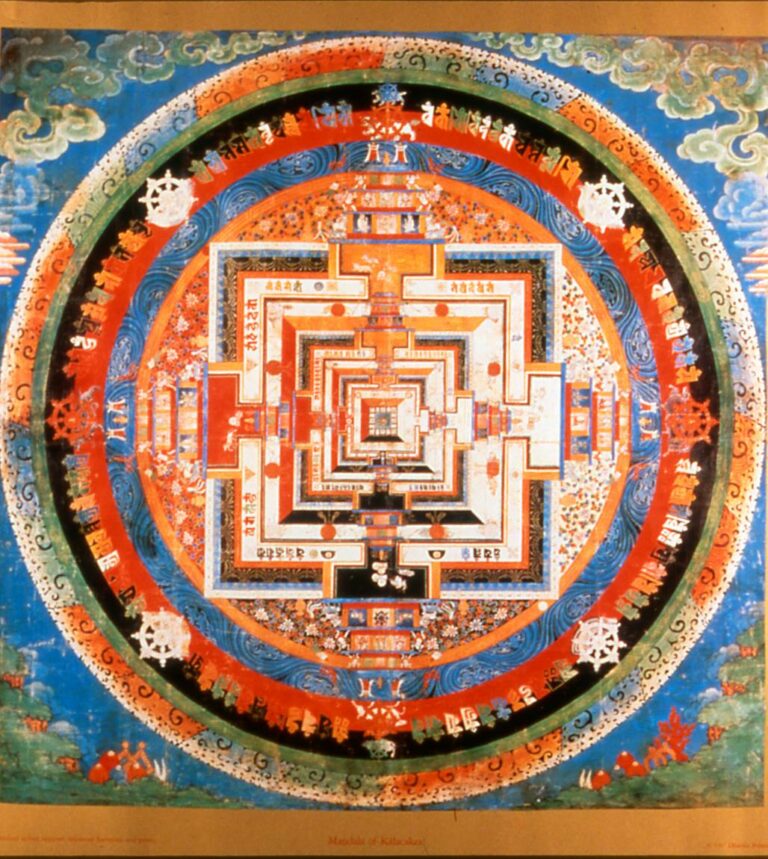
Colors in a Mandala
- White:
- Placement: On the bottom
- Direction: East
- Element: Water
- Emotion: Anger that can transform into reflecting all appearance in perfect symmetry.
- Yellow:
- Placement: On the left
- Direction: South
- Element: Earth
- Emotion: Pride and ego that can transform into recognizing the humanity we all share.
- Red:
- Placement: On the top
- Direction: West
- Element: Fire
- Emotion: Desire, lust, and greed that can transform into compassion
- Green:
- Placement: On the right
- Direction: North
- Element: Wind
- Emotion: Jealousy that can be transformed into all-accomplishing action
- Blue:
- Placement: In the center
- Element: Space
- Emotion: Ignorance that can transform into wisdom and intelligence
The beauty and order of the mandala can inspire us to allow the positive qualities we already intrinsically embody to manifest. Anywhere in the natural world, we can see the five elements interacting harmoniously with grace. In the interplay of thoughts and emotions within our own mind, we can recognize the possibility for each negative manifestation to be transmuted into pure expressions of healing and holistic balance.
The mandala can show us how to skillfully access our own awareness. Just as the colors red, blue, green, white, and yellow can be combined to create a painting of vivid beauty and inspiration, so the thoughts, emotions, and feelings that color our experience can be integrated as a harmonious whole. Awareness and compassion teach us that the cares and concerns of others are like our own. Seeing this, we are well on the way to creating an attitude that sustains harmony within and without, attuning us to the elemental world in which we live.
Tibetan Prayer Flags
According to Tibetan tradition, prayer flags imprinted with sacred images and mantras transmit healing and compassionate energy into the world through the power of the wind. Prayer flags empowered by mantras affect natural, elemental forces on a subtle level, beyond ordinary human perception. As they fly in the wind, the flags exert a protective, balancing influence on the environment and generate a flow of positive conditions for all sentient beings.
Empowerments, Colors and Symbols of Prayer Flags
Each Nyingma flag has been specially designed and empowered by Tarthang Tulku. Symbolic images and colors represent the Buddha families and their qualities. Each image and color relate meaningfully to the whole.
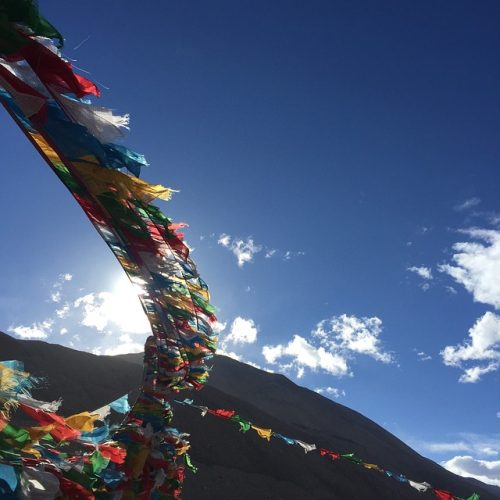
The vajra and the color white represent the transcendent quality of diamond clarity.
The wheel of knowledge and the color blue exemplify awakened mind.
The jewel and the color yellow embody qualities of equanimity and generosity.
The sword and color green stand for meaningful action.
Prayer Flag Production
Prayer flags have been made and flown in Tibet since early in the history of Dharma transmission. The Tibetan Aid Project continues this ancient tradition by creating prayer flags, flown at our organizations
and sold to support TAP’s mission. They can be purchased by contacting tap@tibetanaidproject.org.
- Prayer flags are manually silk-screened on heavy nylon sailcloth and individually sewn by skilled volunteers to a finished size of 42 inches x 56 inches.
- Empowerments are mixed with the inks as a special blessing.
- Special attention is paid to the time of printing; flags are often printed during times of high energy, such as a lunar or solar eclipse.
- Chevron “tongues” in the five colors of the Tibetan mandala direct the flow of the prayers outward into the universe.
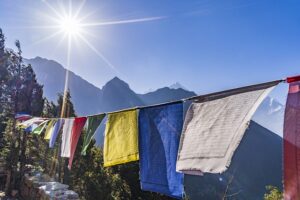
Handling and Hanging Prayer Flags
Because of the sacred nature of prayer flags, they should be treated with special care and respect. Do not let flags touch the ground or use them as articles of clothing.
Auspicious days to hang prayer flags:
- The tenth day following a new moon
- The first day of a full moon
- The tenth day of the lunar month
- The twenty-fifth day of the lunar month
Flags should be flown from a 12-foot pole or from atop a building with the “tongues” in line with the horizon. In normal wind conditions a flag lasts two to three years. Flags beyond repair are buried or burned.
Prayer Wheels
The Prayer Wheel (or Dharma Wheel) is an ancient spiritual tool and a vital part of Tibetan daily life. It is turned at every opportunity in order to activate and extend the blessings of compassion, harmony, and peace to all sentient beings.
Two thousand years ago, the famed Indian Buddhist master Nagarjuna determined that setting the Buddha’s printed words in motion activated the same blessings as reciting them with the human voice. The concept of the prayer wheel is a physical manifestation of the phrase “turning the wheel of Dharma,” which describes the way in which the Buddha taught. Prayer wheels contain the words of the Buddha, teachings of wisdom and compassion, printed on rolls of paper that are glued together and wrapped by hand. Traditionally, the mantra Om Mani Padme Hum is written in Sanskrit on the outside, while the tightly wound scroll on the inside can have a variety of Tibetan prayers that are repeated thousands of times. As a result, each single revolution generates the merit of reciting an immense volume of prayers.
PRODUCING NEW WHEELS
In 1970, Tarthang Rinpoche selected a collection of mantras that were especially beneficial for our times, and trained his students in the traditional method of preparing, printing, and rolling the text for prayer wheels. Instead of handles, which were common for smaller wheels, Rinpoche covered the rolled texts with cloth and mounted them on turntables, harnessing electricity to set the ancient mantras in perpetual motion. In recent years, Tarthang Rinpoche has applied modern computerized typesetting and printing techniques to create wheels equal in content to the largest wheels ever produced in Tibet. This new generation of prayer wheels emulates the traditional Mani Dong-khor, the ten-million mantra wheel highly valued in Tibet.
PRAYER WHEEL DISTRIBUTION
Tibetan Aid Project, in partnership with sister organizations, prepares traditional Tibetan Buddhist prayer wheels that contain mantras of peace, compassion, and protection. These are installed at our local centers and are also distributed to religious practitioners and monasteries at the annual World Peace Ceremony in Bodh Gaya, India. Since 1989, Tibetan Aid Project has shipped and distributed over 176,250 hand prayer wheels to the participants at the World Peace Ceremony.
